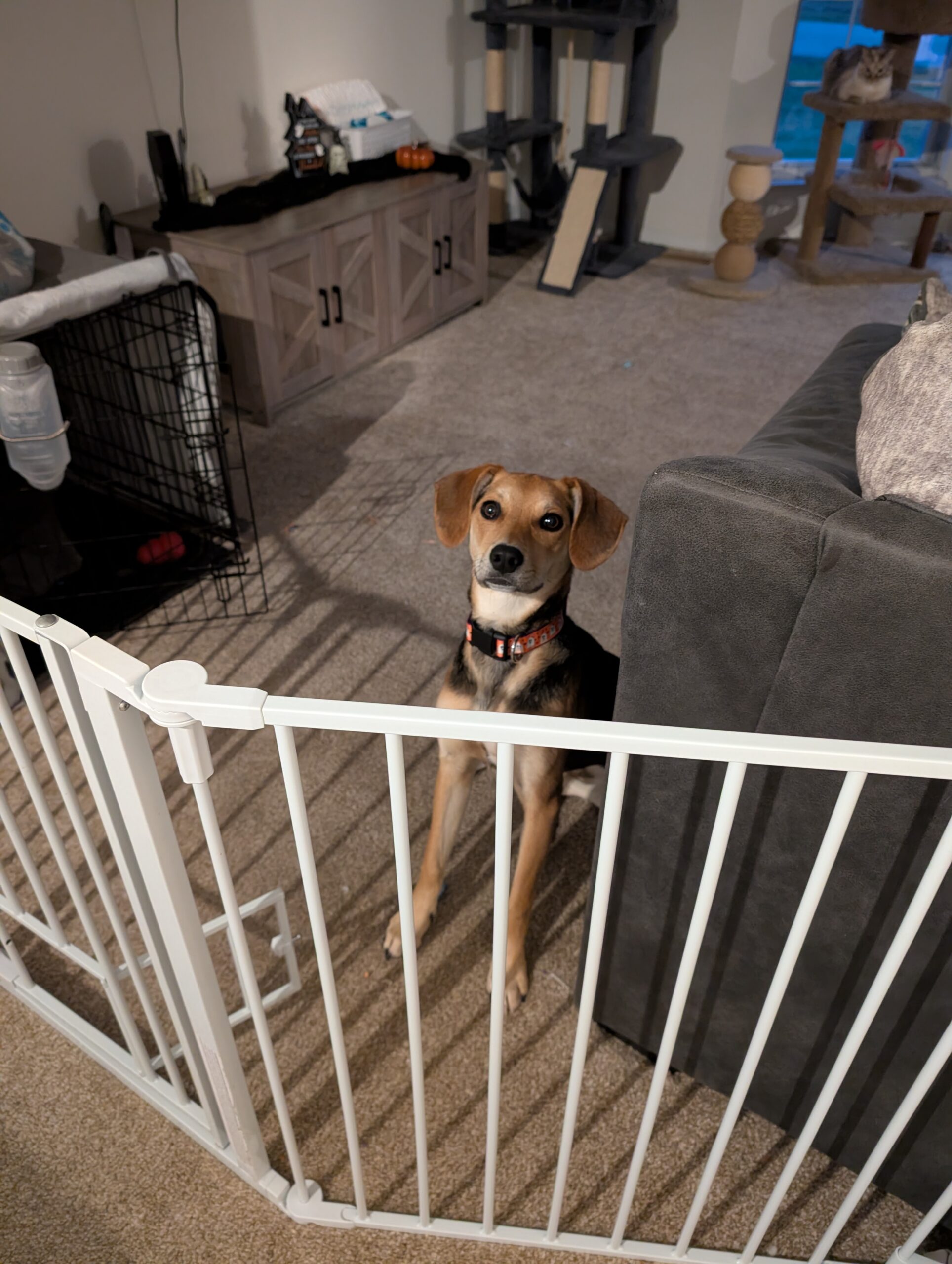Halloween is one of the most exciting nights of the year for families in St. Charles County. Kids dress up, decorations glow, and candy bowls overflow. But for dogs, all that excitement can feel overwhelming.
Doorbells ringing nonstop, loud costumes, flashing lights, and strange smells can trigger anxiety and confusion. Even the calmest dogs can become frightened, slip out a door, or act in ways they normally wouldn’t.
In this Doggy Doods Digest, we’ll help you prepare your dog for Halloween night, manage their stress, and create a safe space where they can relax while the trick-or-treaters have fun.

Halloween introduces sights and sounds dogs aren’t used to. Masks, strange voices, new scents, and unpredictable movements can all make a dog feel uneasy.
The American Veterinary Medical Association (AVMA) explains that changes in routine and exposure to unusual noises are two of the biggest triggers for canine anxiety.
Even friendly dogs can become stressed when the doorbell keeps ringing or groups of children in costumes appear at the door. That stress may show up as:
Pacing or whining
Hiding under furniture
Barking excessively
Trying to run out an open door
Recognizing these signs early helps you take steps before your dog becomes overwhelmed.
Before the trick-or-treaters start arriving, prepare a calm space just for your dog. Choose a room away from the front door where they can feel safe and relaxed.
Tips for creating a stress-free zone:
Close blinds or curtains to block flashing lights and movement outside.
Turn on soft music or a TV to muffle the sound of the doorbell.
Give them their favorite bed, blanket, or toy to make the space feel familiar.
The ASPCA recommends using white noise or calming music to help anxious pets relax.
If your dog enjoys their crate, place it in this quiet area and leave the door open so they can come and go freely.
If your dog gets anxious when the doorbell rings, a little practice in the days leading up to Halloween can make a big difference.
Start by ringing the doorbell or knocking lightly, then reward your dog for staying calm. Repeat several times a day, gradually increasing the sound or number of rings. Rewarding calm behavior helps your dog associate the noise with something positive instead of stressful.
The American Kennel Club (AKC) suggests pairing potentially stressful sounds with treats to reframe your dog’s response.
Halloween night brings plenty of opportunities for dogs to escape. With doors opening and closing for trick-or-treaters, even a well-trained dog might slip outside.
To prevent escapes:
Keep your dog in a separate room before visitors arrive.
If they must stay near the door, use a baby gate or leash to create a barrier.
Make sure your dog’s collar and ID tags are on and up to date.
The AVMA also recommends that all pets be microchipped so if they do run off, shelters can quickly identify and return them.
If your dog tends to dart out the door, you may also want to greet trick-or-treaters on the porch rather than letting them ring the bell.
While dressing up your dog can be adorable, not all dogs enjoy wearing costumes. Tight clothing, hats, or masks can restrict movement and make them feel trapped.
According to the Pet Poison Helpline, some costume materials may even contain dyes or small parts that can be harmful if chewed.
If you do dress up your dog:
Choose lightweight, comfortable materials.
Avoid anything that blocks vision or covers the ears.
Let them try it on beforehand and reward calm behavior.
If your dog seems uncomfortable, skip the costume and use a festive bandana instead — it’s safer and still fun.
Outdoor Halloween decorations can also cause anxiety. Motion-activated props that scream or flash lights can easily startle dogs on walks or in yards.
If you’re setting up decorations, test them while your dog is nearby to see how they react. If they show fear — tail tucked, cowering, or barking — move those decorations away from areas your dog uses.
Keep walks short on Halloween evening. Loud sounds and crowded sidewalks can be stressful, even for social dogs.
Positive reinforcement is one of the most effective ways to reduce stress. Keep treats nearby and reward your dog anytime they stay calm during commotion.
Dogs are more likely to repeat behaviors that earn praise or snacks. Over time, this can help your pup feel more confident and less reactive to Halloween noises and visitors.
You can also use interactive toys or long-lasting chews to keep them occupied while you hand out candy.
Once the last trick-or-treater has gone home, give your dog some quiet time and a chance to unwind. A quick walk around the yard or cuddle on the couch can help them settle back into their normal routine.
If candy or wrappers have fallen outside, pick them up before your dog goes out again — chocolate, xylitol, and even small bits of plastic can be dangerous.
A clean, safe yard helps protect your dog year-round. Doggy Doods proudly serves St. Peters, O’Fallon, Wentzville, and surrounding areas in St. Charles County, keeping outdoor spaces dood-free and ready for every season.
If Halloween cleanup feels like one more task on your list, we can help. Get a free quote today to keep your yard fresh, clean, and pet-safe.
Does your dog get nervous on Halloween night? What helps calm them down — a quiet room, background music, or their favorite treat? Share your tips in the comments and help other local pet parents make the night a little less scary. 🐾💜
Learn which spooky decorations can frighten or harm dogs — and how to keep your Halloween setup fun and pet-friendly.
2 Responses
Great tips for keeping pups safe on Halloween and other high stimulating nights!
We try our best to give great tips! Halloween can be a stressful day for pups.